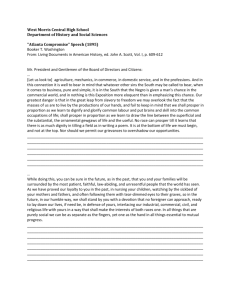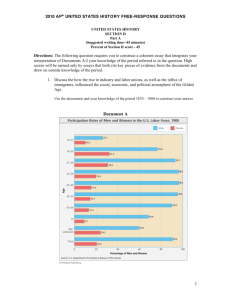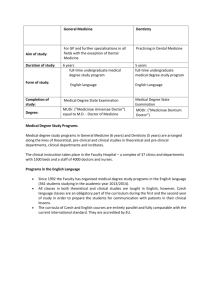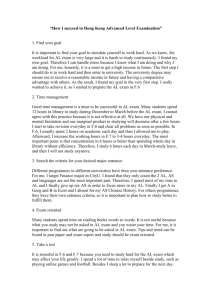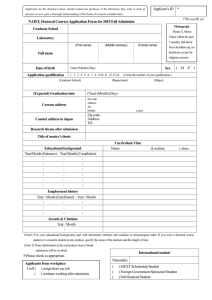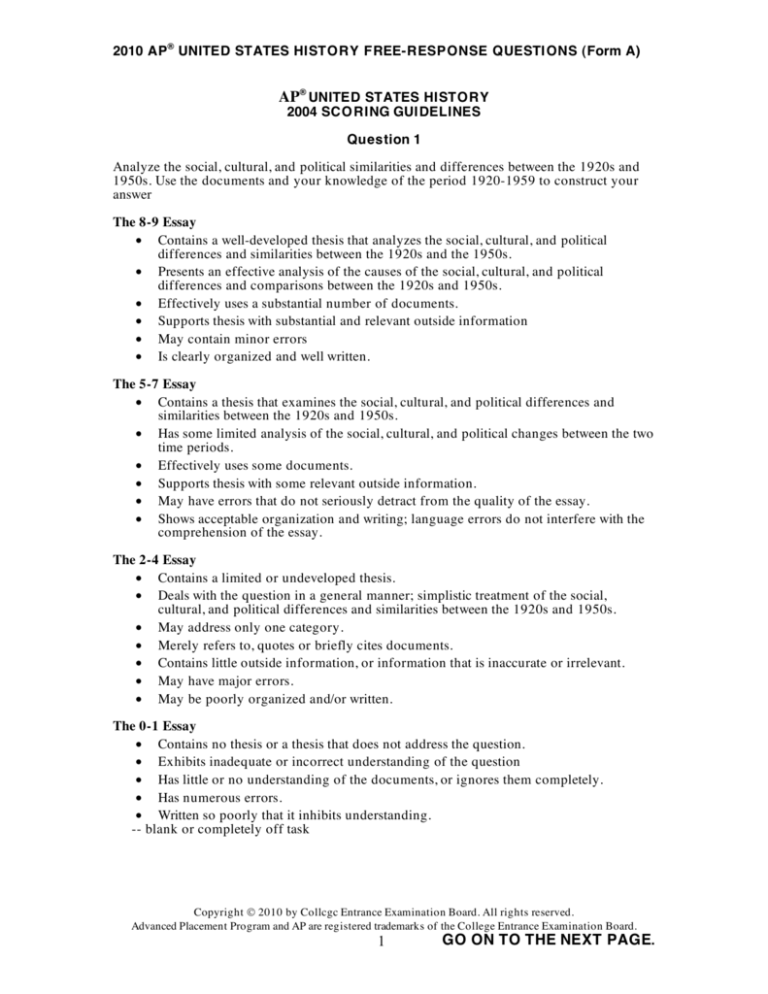
2010 AP® UNITED STATES HISTORY FREE-RESPONSE QUESTIONS (Form A)
AP® UNITED STATES HISTORY
2004 SCO RING GUIDELINES
Question 1
Analyze the social, cultural, and political similarities and differences between the 1920s and
1950s. Use the documents and your knowledge of the period 1920-1959 to construct your
answer
The 8-9 Essay
• Contains a well-developed thesis that analyzes the social, cultural, and political
differences and similarities between the 1920s and the 1950s.
• Presents an effective analysis of the causes of the social, cultural, and political
differences and comparisons between the 1920s and 1950s.
• Effectively uses a substantial number of documents.
• Supports thesis with substantial and relevant outside information
• May contain minor errors
• Is clearly organized and well written.
The 5-7 Essay
• Contains a thesis that examines the social, cultural, and political differences and
similarities between the 1920s and 1950s.
• Has some limited analysis of the social, cultural, and political changes between the two
time periods.
• Effectively uses some documents.
• Supports thesis with some relevant outside information.
• May have errors that do not seriously detract from the quality of the essay.
• Shows acceptable organization and writing; language errors do not interfere with the
comprehension of the essay.
The 2-4 Essay
• Contains a limited or undeveloped thesis.
• Deals with the question in a general manner; simplistic treatment of the social,
cultural, and political differences and similarities between the 1920s and 1950s.
• May address only one category.
• Merely refers to, quotes or briefly cites documents.
• Contains little outside information, or information that is inaccurate or irrelevant.
• May have major errors.
• May be poorly organized and/or written.
The 0-1 Essay
• Contains no thesis or a thesis that does not address the question.
• Exhibits inadequate or incorrect understanding of the question
• Has little or no understanding of the documents, or ignores them completely.
• Has numerous errors.
• Written so poorly that it inhibits understanding.
-- blank or completely off task
Copyright 2010 by Collcgc Entrance Examination Board. All rights reserved.
Advanced Placement Program and AP are registered trademarks of the College Entrance Examination Board.
1
GO ON TO THE NEXT PAGE.
2010 AP® UNITED STATES HISTORY FREE-RESPONSE QUESTIONS (Form A)
UNITED STATES HISTORY
SECTION I1
Part A
(Suggested writing time--45 minutes)
Percent of Section II score –45
Directions: The following question requires you to construct a coherent essay that integrates
your interpretation of Documents A-H and your knowledge of the period referred to in the
question. High scores will be earned only by essays that both cite key pieces of evidence from
the documents and draw on outside knowledge of the period.
1. Analyze the social, cultural, and political similarities and differences between the
1920s and 1950s.
Use the documents and your knowledge of the period 1920-1959 to construct your
answer
Document A
Source: Wickersham Commission on Law Observance and Enforcement, January 20,
1931
Just as the steadily growing market for industrial alcohol led to improved methods
and use of new raw materials admitting of greater speed and quantity of production
in legitimate distilling, so the growing demand for distilled liquor after the National
Prohibition Act led to discovery of new and improved apparatus, new methods and
new materials for illicit production. In particular, it has led to discovery of new
methods of speedy ageing whereby liquor of good quality may be made in a very
short time. The methods of the pre-prohibition moonshiner are as obsolete as those
of the pre-prohibition legitimate distiller.
Document B
Source: United States Statutes at Large, 57th Cong., Sess. I, Chp. 8, p. 5-7, May 19,
1921
… the number of aliens of any nationality who may be admitted under the
immigration laws to the United States in any fiscal year shall be limited to 3 per
centum of the number of foreign born persons of such nationality resident in the
United States as determined by the United States census of 1910.
Document C
Source: Brown v. Board of Education (1954) United States Supreme Court, From:
74 Supreme Court Reporter, p. 686-693
We conclude that in the field of public education the doctrine of "separate but
equal" has no place. Separate educational facilities are inherently unequal.
Therefore, we hold that the plaintiffs and others similarly situated for whom the
actions have been brought are, by reason of the segregation complained of, deprived
of the equal protection of the laws guaranteed by the Fourteenth Amendment. This
disposition makes unnecessary any discussion whether such segregation also violates
the Due Process Clause of the Fourteenth Amendment.
Copyright 2010 by Collcgc Entrance Examination Board. All rights reserved.
Advanced Placement Program and AP are registered trademarks of the College Entrance Examination Board.
2
GO ON TO THE NEXT PAGE.
2010 AP® UNITED STATES HISTORY FREE-RESPONSE QUESTIONS (Form A)
Document D
Source: Dress Code for High School Students in New York, Board of Education,
Buffalo, New York January 24, 1956
BOYS
ACADEMIC HIGH SCHOOLS AND HUTCHINSON-TECHNICAL HIGH
SCHOOL
Recommended:
Dress shirt and tie or conservative sport shirt and tie with suit jacket, jacket, sport
coat, or sweater
Standard trousers or khakis; clean and neatly pressed
Shoes, clean and polished; white bucks acceptable
Not Recommended:
Dungarees or soiled, unpressed khakis
T-shirts, sweat shirts
Extreme style of shoes, including hobnail or "motorcycle boots"
Note: The apparel recommended for boys should be worn in standard fashion with
shirts tucked in and buttoned, and ties tied at the neck. Standard of dress for boys,
while in school shops or laboratories, should be determined by the school.
GIRLS
ACADEMIC AND VOCATIONAL HIGH SCHOOLS
Recommended:
Blouses, sweaters, blouse and sweater, jacket with blouse or sweater
Skirts, jumpers, suits or conservative dresses
Shoes appropriate to the rest of the costume
Not Recommended:
V-neck sweaters without blouse
Bermuda shorts, kilts, party-type dresses, slacks of any kind
Ornate jewelry
T-shirts, sweat shirts
Copyright 2010 by Collcgc Entrance Examination Board. All rights reserved.
Advanced Placement Program and AP are registered trademarks of the College Entrance Examination Board.
3
GO ON TO THE NEXT PAGE.
2010 AP® UNITED STATES HISTORY FREE-RESPONSE QUESTIONS (Form A)
Document E
Source: Kurian, Datapedia of the United States
Year
1918
1919
1920
1921
1922
1923
1924
1925
1926
1927
1928
1929
1930
Number of
Passenger Cars
934.4
1,651.6
1,905.5
1,468.0
2,274.1
3,624.7
3,185.8
3,735.1
3,692.3
2,936.5
3,775.4
4,455.1
2,787.4
Document F
Source: National Archives and Records Administration, Levittown 1950s
Copyright 2010 by Collcgc Entrance Examination Board. All rights reserved.
Advanced Placement Program and AP are registered trademarks of the College Entrance Examination Board.
4
GO ON TO THE NEXT PAGE.
2010 AP® UNITED STATES HISTORY FREE-RESPONSE QUESTIONS (Form A)
Document G
Source: “Communists in the State Department ”Speech by Joseph McCarthy, 1950
The reason why we find ourselves in a position of impotency is not because our
only powerful, potential enemy has sent men to invade our shores, but rather
because of the traitorous actions of those who have been treated so well by this
nation. It has not been the less fortunate or members of minority groups who have
been selling this nation out, but rather those who have had all the benefits that the
wealthiest nation on earth has had to offer—the finest homes, the finest college
education, and the finest jobs in government we can give.
Document H
Source: Library of Congress, 1920
Copyright 2010 by Collcgc Entrance Examination Board. All rights reserved.
Advanced Placement Program and AP are registered trademarks of the College Entrance Examination Board.
5
GO ON TO THE NEXT PAGE.
2010 AP® UNITED STATES HISTORY FREE-RESPONSE QUESTIONS (Form A)
Document Information and Inferences – DBQ 2010
Document A: Wickersham Commission on Law Observance and Enforcement
Document Information
• It is a report on the effects prohibition had on alcohol.
• Methods to produce illegal alcohol have become more efficient and make higher
quality products.
• Prohibition has improved the production of alcohol
Document Inferences
• This demonstrates the rebellious attitude of the 20 ’s because prohibition is being
openly ignored.
• Showed resistance to authority, this is different than the more conforming lifestyle of
the 50s.
Document B: Emergency Quota Act
Document Information
• Congress has passed the Emergency Quota Act.
• This limits the amount of immigrants from countries based on the amount of
immigrants already in the United States.
•
Document Inferences
• Displays anti-immigrant feelings in the 1920s
• Was aimed at removing the “wrong immigrants, ” those from southern and eastern
Europe.
• Ties in with the Red Scare, because the United States was afraid of foreign ideas
Document C: Brown v Board of Education
Document Information
• Brown is arguing against the doctrine of “separate but equal, ” because separate
education is inherently unequal.
• The 14 th amendment is being broken by the segregation of schools.
Document Inference
• The 1950s were the major start of the civil rights movement.
• Brown was going against the old standards.
• This contrasts to the 20s. The 20’s had a large growth in racism in the resurgence of
the Ku Klux Klan.
• The desegregation of schools began to take place.
Document D: Dress Code for High School Students in New York
Document Information
• The male students have to wear very neat clothes and tuck it in.
• Boys should not look sloppy.
• The girls were to also dress nicely.
Copyright 2010 by Collcgc Entrance Examination Board. All rights reserved.
Advanced Placement Program and AP are registered trademarks of the College Entrance Examination Board.
6
GO ON TO THE NEXT PAGE.
2010 AP® UNITED STATES HISTORY FREE-RESPONSE QUESTIONS (Form A)
Document Inferences
• This displays the conformity of the 1950s.
• The schools wanted to put off a very neat persona.
• This contrasts with the 20s. The 20’s had more prevalent individualism.
Document E: Chart on the Number of Passenger Cars
Document Information
• The amount of cars grows during the time frame 1818 to 1829. However, in 1930 the
amount drops.
Document Inferences
• The start of the consumer society was in the 20 ’s.
• The amount of cars drops in 1930 because of the start of the Great Depression
• Families purchased cars on easily available credit, the growing debt would lead to the
depression.
• More cars were purchased as suburbs grew.
• The 1950s also had large amounts of consumerism and the suburbs played a central
roll in many American families
Document F: Levittown Photograph
Document Information
• There are many houses with small variation
• They are all close to each other.
• It is a planned community
Document Inferences
• The suburbs played a crucial roll in American society during the 1950s.
• The availability of cheap housing for middle class families.
• The suburbs were also a major part of the 1920s.
• The automobile allowed the middle class to escape the city.
Document G: Joseph McCarthy – “Communists in the State Department”
Document Information
• McCarthy blames the US’s impotency on traitors
• He says that the wealthiest of the nation are to blame.
•
Document Inferences
• The spread of communism after World War II frightened many Americans.
• This fear caused the Second Red Scare
• Similar to the first Red Scare, a government official took control and began to target
people. In the 20’s Palmer led the Palmer raids.
• These raids differed because it targeted immigrants and foreigners while McCarthy ’s
raids centered around major icons such as television writers and actors.
Copyright 2010 by Collcgc Entrance Examination Board. All rights reserved.
Advanced Placement Program and AP are registered trademarks of the College Entrance Examination Board.
7
GO ON TO THE NEXT PAGE.
2010 AP® UNITED STATES HISTORY FREE-RESPONSE QUESTIONS (Form A)
Document H – Flappers Dance the Charleston
Document Information
• Two flapper girls dance the Charleston in front of a man.
• They are wearing clothes that used to be considered inappropriate for a woman
Document Inferences
• The flappers represented a changing roll in women. They were emerging from their
previously submissive roles.
• They have confidence.
• This compares with the 1950s because in the 1950s women were regressing back to
republican motherhood.
Copyright 2010 by Collcgc Entrance Examination Board. All rights reserved.
Advanced Placement Program and AP are registered trademarks of the College Entrance Examination Board.
8
GO ON TO THE NEXT PAGE.
2010 AP® UNITED STATES HISTORY FREE-RESPONSE QUESTIONS (Form A)
Document Information and Inferences -- DBQ 2010 [cont’d]
Commonly Seen Relevant Outside Information
Red Scare
Palmer Raids
Scopes Trial (1925)
Republican Motherhood
Jazz Age
Flapper
“ Lost Generation ”
Harlem Renaissance
Henry Ford
Model T
Ku Klux Klan
Emergency Quota Act of 1921
National Origins Act of 1924
Jazz Age
Flapper
Brown V. Board of Education (1954)
Montgomery Bus Boycott (1955)
Taft-Harley Act
Fair Deal
Truman
Suburbs
Beatniks
McCarthyism
Cold War
The Charleston
Prohibition
William Levitt
Ike Eisenhower
Warren G Harding
Interstate Highway Act
Speakeasy
Little Rock Nine
Copyright 2010 by Collcgc Entrance Examination Board. All rights reserved.
Advanced Placement Program and AP are registered trademarks of the College Entrance Examination Board.
9
GO ON TO THE NEXT PAGE.
2010 AP® UNITED STATES HISTORY FREE-RESPONSE QUESTIONS (Form A)
Bibliography
Works Cited
Board of Education, Buffalo, New York. "Dress Code for High School Students in New York."
American History Online. Facts On File,
Inc. http://www.fofweb.com/activelink2.asp?ItemID=WE52&iPin=E14091&SingleRec
ord=True (accessed April 29, 2010).
"Flappers Dance the Charleston." Library of Congress. Prints and Photographs Division.
American History Online. Facts On File,
Inc. http://www.fofweb.com/activelink2.asp?ItemID=WE52&iPin=AHI8093&SingleRe
cord=True (accessed April 29, 2010).
"Levittown, Pennsylvania." National Archives and Records Administration. American History
Online. Facts On File,
Inc. http://www.fofweb.com/activelink2.asp?ItemID=WE52&iPin=AHI0760&SingleRe
cord=True (accessed April 29, 2010).
McCarthy, Joseph. “Communists in the State Department. ” American History Online. Web.
29 Apr. 2010.
<http://www.fofweb.com/activelink2.asp?&#8232;ItemID=WE52&iPin=E14047&Sing
leRecord=True >.
“ M otor Vehicle Sales in the United States." American History Online. Facts On File,
Inc. http://www.fofweb.com/activelink2.asp?ItemID=WE52&iPin=AHI5497&SingleRe
cord=True (accessed April 29, 2010).
U.S. Congress. "Emergency Quota Act." United States Statutes at Large, 57th Cong., Sess. I,
Chp. 8, p. 5-7. American History Online. Facts On File,
Inc. http://www.fofweb.com/activelink2.asp?ItemID=WE52&iPin=E02140&SingleRec
ord=True (accessed April 29, 2010).
U.S. Supreme Court. "Brown v. Board of Education." 74 Supreme Court Reporter, p. 686693. American History Online. Facts On File,
Inc. http://www.fofweb.com/activelink2.asp?ItemID=WE52&iPin=E09910&SingleRec
ord=True (accessed April 29, 2010).
Wickersham Commission on Law Observance and Enforcement. "Report on the Enforcement
of the Prohibition Laws of the United States (excerpt)." American History Online.
Facts On File,
Inc. http://www.fofweb.com/activelink2.asp?ItemID=WE52&iPin=E14034&SingleRec
ord=True (accessed April 29, 2010).
Copyright 2010 by Collcgc Entrance Examination Board. All rights reserved.
Advanced Placement Program and AP are registered trademarks of the College Entrance Examination Board.
10
GO ON TO THE NEXT PAGE.


